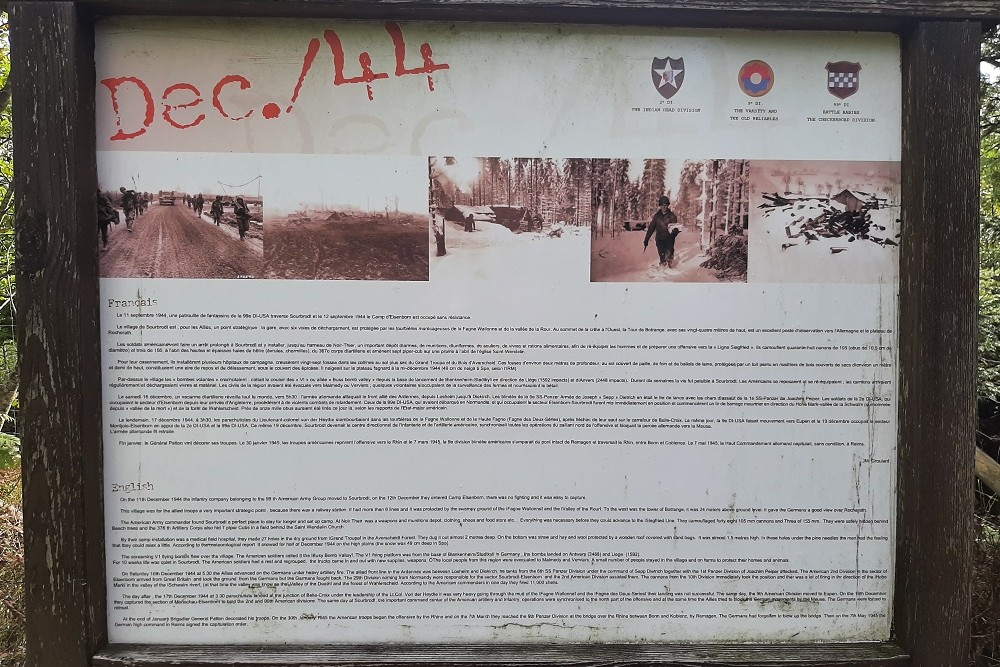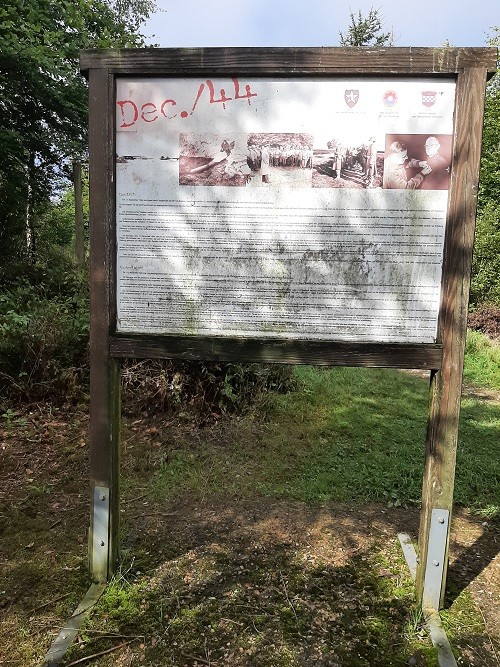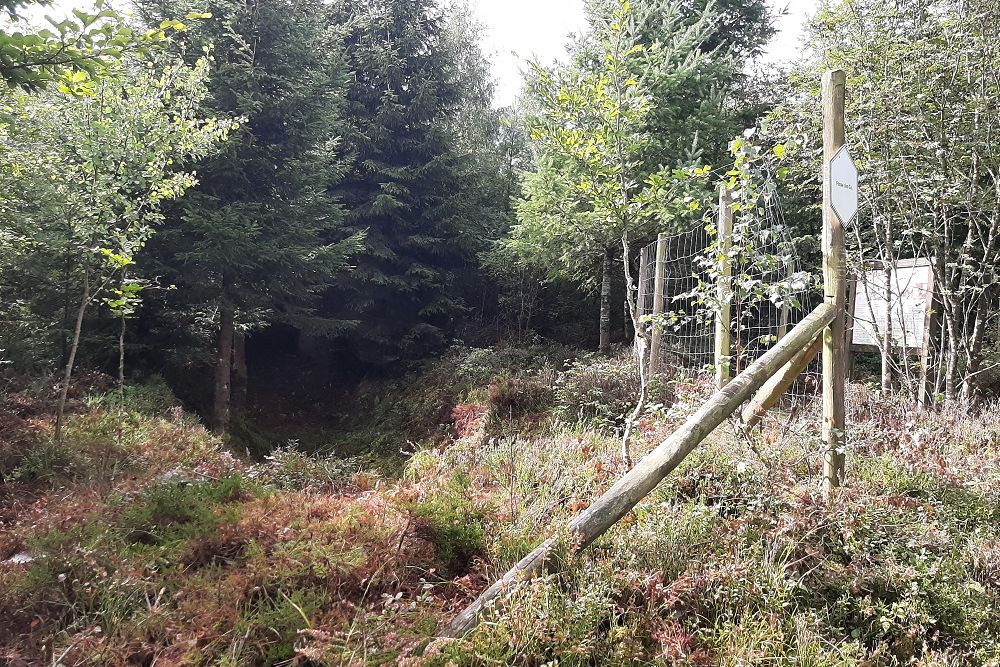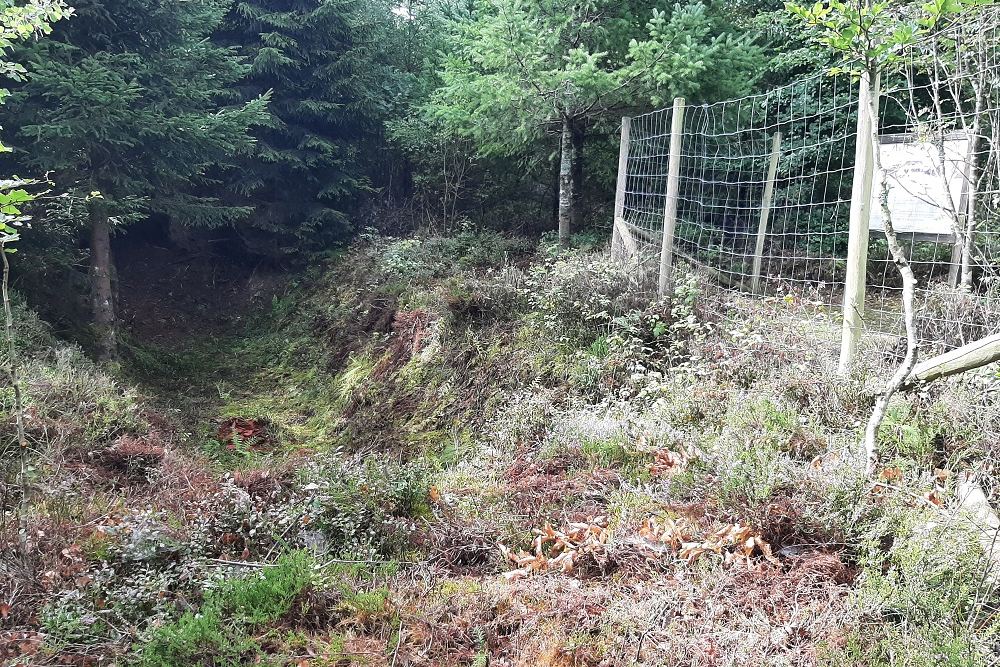Route of Commemoration No.6: December '44
On December 11, 1944, a division of infantry belonging to the 99th American Army Group entered Sourbrodt and on September 12, the Elsenborn camp was captured without a fight.
This village was a very important strategic point for the Allied troops because it had a railway station with 6 tracks and completely protected by the swampy peat area of the "Fagne Wallonne" and the "Valley of the Roer". To the west was also the tower of Botrange which, rising 24 meters above the land, made it possible to observe part of Germany and the Rocherath plateau.
The American army command found Sourbrodt a suitable place for a longer stay and settled there. As far as the hamlet of Noir-Thier, they set up an important weapons depot, which they filled with weapons, ammunition, clothing, footwear, food, etc. Everything needed to prepare the intended attack on the "Siegfried Line". They camouflaged 48 105mm guns (10.5 is the diameter of the projectiles) and three 150mm guns, protected by the high beech hedges and by the 376th artillery corps and furthermore they hid about 7 Piper-Cubs on a meadow in the shelter of the Saint Wendelln Church.
At their encampment they installed field hospitals and dug 27 holes in the dry soil of "Grand Troupa" and the Averscheid forest. These excavations, about 2 meters deep, were provided with straw, hay and wool at the bottom, protected by a canopy of thick wooden planks with sandbags on them, about one and a half meters high. In these holes, under the fir trees, one had a feeling of peace and could relax. According to the IRM, it snowed on the peat plateau in mid-December 1944 (49 cm of snow in Spa).
The "V1" or flying bombs flew above the village with a roar. The American soldiers spoke of "The Bussy Bomb Alley". The V1s are launched from the Blankenheim/Stadtkyll base in Germany with destinations Antwerp (2448) and Liège (1592).
For 10 weeks, life was relatively quiet in SOubredt. The Americans rested and reformed, while the trucks drove back and forth with the food, weapons and other goods needed for the approaching offensive. The civilian population of the region had mainly been evacuated to Malmedy or Verviers. A small number of volunteers remained in the village to protect the farms and houses and care for the livestock.
On Saturday, December 16, 1944 at 5:30 am, all hell broke loose when the Germans, under heavy artillery fire, attacked the Allied front line in the Ardennes between Losheim and Diekirch. The tanks of the 6th SS Panzer Division commanded by Sepp Dietrich, assisted by Joachim Peiper's 1st Panzer Division, attacked. The men of the 2nd American Division, which had occupied the Elsenborn sector since their arrival from Great Britain, resisted the German attacks aimed at recapturing the region. While the 29th American Division from Normandy, and responsible for the Elsenborn-Sourbrodt sector, provided assistance to the 2nd American Division. The guns of the 10th Division immediately took up position and gave murderous fire in the direction of the "Hoge-Mark" in the valley of the Schwalm River (from then on called "Valley of Death") and the forest of Wahlerscheid. About 1,000 shells were fired that day, according to US military command.
The next day, December 17, 1944 at 3:30 am, paratroopers landed at Belle-Croix under the command of Lieutenant Colonel Von de Heydig, and dredged through the mud of the "Fagne-Wallone" and the "Fagne des Deux-Seriès", their landing was a failure. The same day the 9th American Division headed for Eupen. On December 19, they occupied the Monschau-Elsenborn section in support of the 2nd and 99th American divisions. The same day, Sourbrodt became the command center of the American artillery and infantry that synchronized all operations of that northern part of the offensive and at the same time blocked the progress of the German army towards the Meuse. Ultimately the Germans had to withdraw.
In late January, Brigadier General Patton decorated his troops. On January 30, 1945, the American troops resumed the offensive on the Rhine and on March 7, the 9th Armored Division reached the bridge over the Rhine between Bonn and Koblenz at Remagen, which the Germans had failed to blow up. All this resulted in the unconditional capitulation of the German Empire, signed in (Compagne) Reims on May 7, 1945.
Do you have more information about this location? Inform us!
Source
- Text: TracesOfWar
- Photos: Hans Tasma
Related books
Nearby
Point of interest
- Route of Commemoration No.5: The Cross fort he Russian Prisoners - Sourbrodt (Waimes)
- 0.4 km
- Route of Commemoration No.7: Baltia Mound - Botrange (Waimes)
- 2.8 km
- Remains of Security Building PD25bis - Bütgenbach
- 3.0 km
Monument
- Russian Cross Sourbrodt - Sourbrodt (Waimes)
- 0.4 km
- War Memorial Sourbrodt - Sourbrodt (Waimes)
- 1.7 km
- Memorial War Victims Ovifat - Ovifat (Waimes)
- 3.2 km
Cemetery
- Belgian War Graves and Memorial Robertville - Robertville (Waimes)
- 4.1 km
- Russian War Graves Nidrum - Nidrum
- 7.1 km
- German War Graves Waismes - Waimes
- 7.8 km













